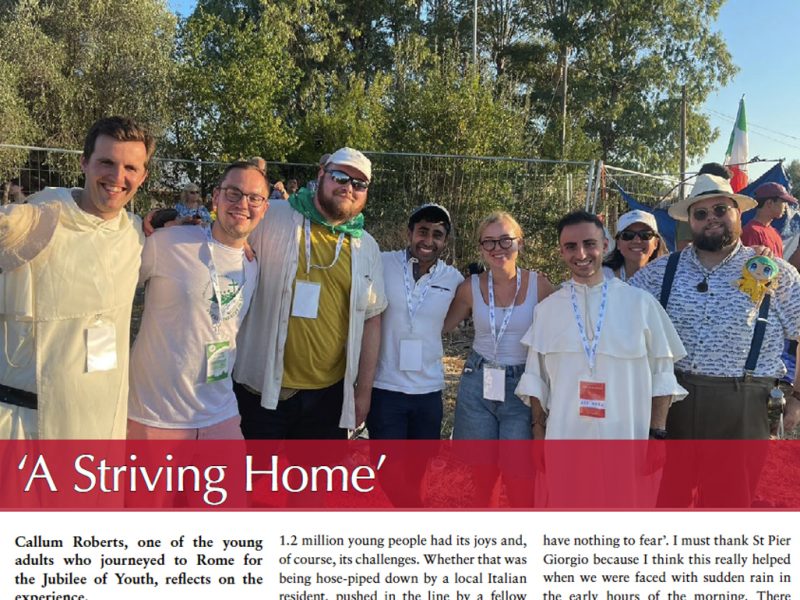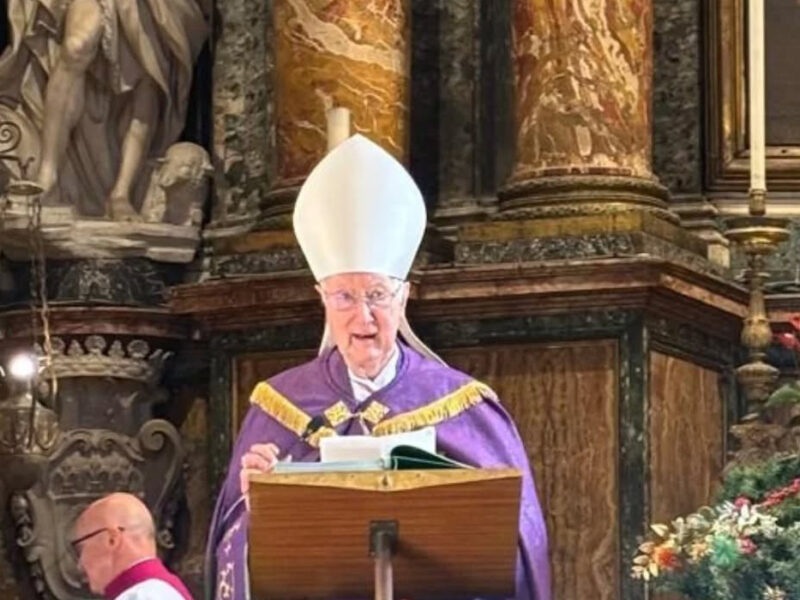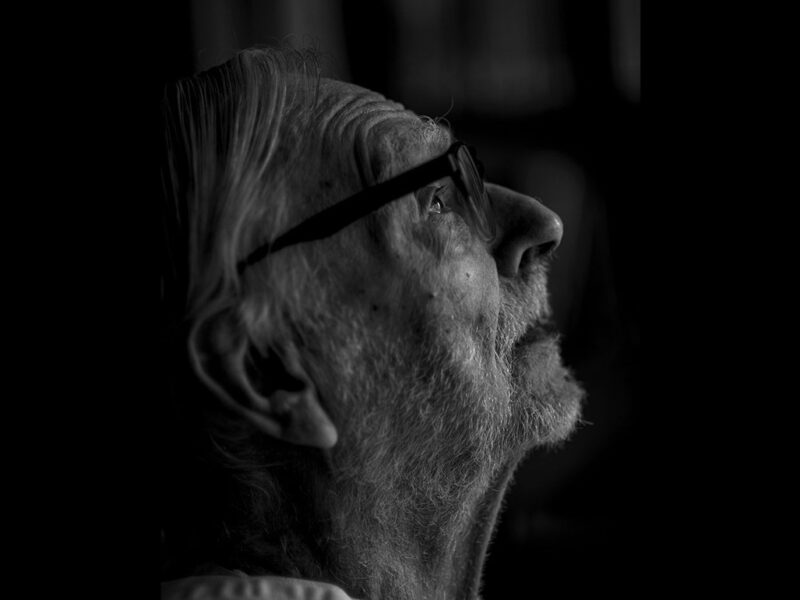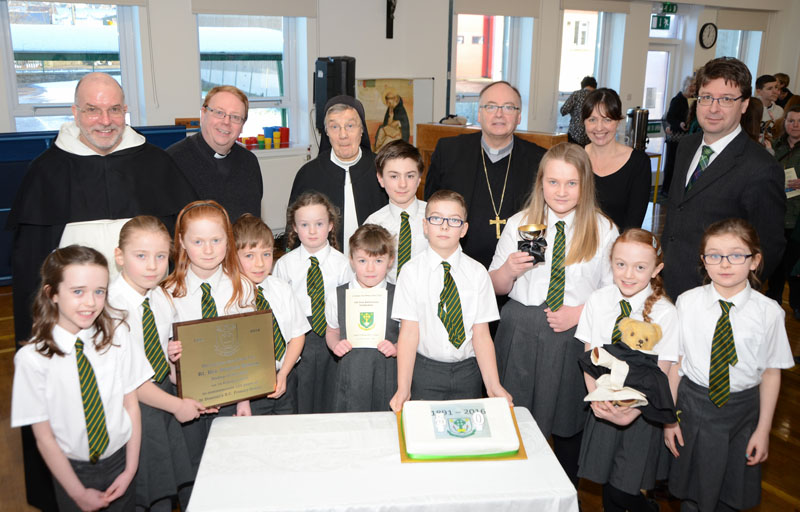
St Dominic’s School, Crieff, celebrates triple anniversary

On Sunday 14th February 2016, St Dominic’s Primary School, Crieff, celebrated the 800th Anniversary of the Dominican Order, the 125th Anniversary of their school’s founding, and the 50th Anniversary at their current site!
A Living Continuity
Rev Dr Thomas Shields celebrated Mass for the occasion in the nearby St Fillan’s Church, accompanied by Sr Pauline Burling OP, Mother General of the school’s founding order, Br Andrew Brookes OP, Dominican friar and a son of the parish, and Mrs Elizabeth Hunter, headteacher, with her staff and pupils.
Bishop Stephen Robson, of Dunkeld, blessed a plaque to mark the anniversary. He paid tribute to the long line of teachers who had served at the school and to the families who had sacrificed so much for their children’s future. He told the pupils:
“Today you are the living continuity of all those boys and girls who have been a part of this community over all those years.”
Mrs Hunter thanked the generations of staff, families and parishioners.
“They have left us such a rich legacy and we look forward with hope for the future. Our journey began 125 years ago when the first parents entrusted their children’s education to the Dominican nuns who had travelled to Crieff to establish a convent and school. We are entrusted to care for that living community, bearing witness to a common vision and mission. We are one big family who trust in their faith. Everyone is equally respected and unconditionally loved in a community which wants to reach out to all, especially the poor and the marginalised, and those in greatest need.”
Sr Pauline, accompanied by Mrs Jenny Turnbull, led the school in singing a Dominican 13th-Century Blessing:
May God, Creator, bless us.
May God, Redeemer, heal us.
May God the Holy Spirit, fill us with light.

Br Andrew Brookes OP & Br Dominic Humbert, the school mascot.
Brief history of the school’s foundation
Br Andrew Brookes describes the school’s early days, when the Dominican Order first came to Crieff:
“Mrs Mary Helen Elwes (Mother Mary Ignatius), the foundress of the school was the daughter of a prominent local family, the Murrays of Dollerie. Widowed, she had become a Catholic and joined the Dominican convent in Stone, Staffordshire, in 1870. “In 1889 the diocese of Dunkeld invited her to found a convent and school which she promptly did on land next to Strathearn Terrace. Professional lay teachers were employed from the outset, the nuns also teaching. Despite many hardships, the school flourished, supported by a small government grant but dependent mostly on the generosity of Catholics, and in 1897 had to move to a bigger site on what is now the Parish car park. Mother Ignatius died on the last day of 1899, the convent not surviving much longer. However, the school continues to express the Dominican values of truth, prayer, affirmation of the whole person, community, mercy and care for others.
“In 1919 the school came under the Perthshire Education Authority, and later Perth and Kinross, lifting a financial burden from the parish. The generosity of the parish and the families nevertheless continues to the present day. Chairman of the Parent Council, Dr Harry Schnitker, presented a new 125th Anniversary Trophy to the school. ‘The school has a strong tradition of support from the local community, and particularly the parish of St Fillan’s, here in Crieff.”
Fuller details of the history of the Convent and School can be found below.
Memorabilia
Following the ceremonies, parents and pupils, past and present, were invited to visit the classrooms where the walls were lined with old photos and other memorabilia that had been loaned for the occasion. Sr Pauline and Br Andrew looked back through the school’s opening Log Book with Mrs Hunter, and were moved to read the accounts of ill health and other struggles that showed the great sacrifices that had to be made in the early days.
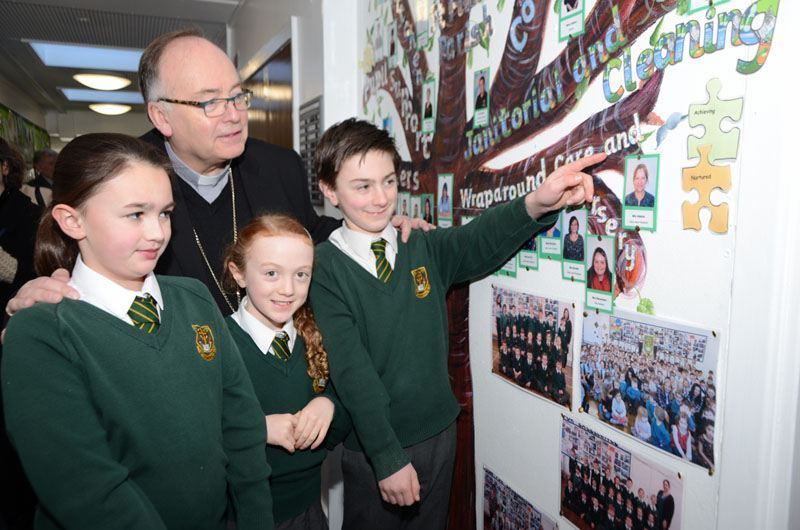
 St Dominic’s School c.1895
St Dominic’s School c.1895
A History of the Dominican Convent of St Mary, and St Dominic’s Primary School, in Crieff
By Br Andrew Brookes OP

Fr Andrew Brookes OP standing at the second site of St Dominic’s School
Personal Connections
I have had family connections with Crieff since 1990 and lived here from 1995-97, living in Tayside until 2006 and then intermittently again in Crieff until I joined the Dominicans in 2009.
I had long wondered if the Roman Catholic School called St Dominic’s indicated links to the Dominican Order and if it was possibly founded by Dominican sisters. Nothing had come to light until January this year when the school secretary sent me a short email saying the school was founded by a Dominican sister from Stone.
Consultation of the recent book ‘A peculiar Kind of Mission’ by Anselm Nye included a paragraph on the foundation of this convent by Sr Mary Ignatius Elwes. To my surprise, with access to various archives in the space of a month I was able to put together quite a detailed account of her life, and of the convent she founded that closed shortly after her death, and also of the early years of the school she also founded and which still continues. There is still more to be found out, and further records to be consulted, but it seems appropriate in this Jubilee year which also marks the 125th anniversary of the school and the 50th year of its present building, to make available the account that follows. I am grateful to those who gave me access to materials, most notably Anselm Nye, The Stone Sisters, St Dominic’s Primary School, and Colin Mayall. Andrew Brookes OP, February 2016.
Founder
St Dominic’s Roman Catholic Primary School in Crieff, Perthshire, along with the short-lived Convent of St Mary in Crieff, were both founded by Mary Helen Elwes. Her maiden name was Murray, and her religious name was Sister – and then Mother – Mary Ignatius.
Mary’s father was Alexander Murray (1810-1884), the youngest son of Anthony Murray, the 9th Laird of Dollerie – a Murray family of significant local prominence in the Crieff area. Her family was of the Episcopal tradition. Her father became famous for mapping out much of Newfoundland, and was honoured by the Queen and Canada for doing so. Having previously worked in the Royal Navy and then in Canada, Alexander married Fanny Cooper Judkins in Scotland in 1857 and emigrated to Canada the following year to run a farm.
Mary Helen Murray was born on 2 October 1838 in the village of Woodstock near Baie Verte in the northern part of Newfoundland, Canada. Her brother, Alexander Hepburn Murray (who became a Major-General in the British Army, dying in 1914) was born in 1840. They returned to Britain between 1841-43 before Alexander returned to Canada to take up the geological and mapping work that would make him famous. In due course, he was appointed a Companion of the Most Distinguished Order of St Michael and St George, i.e. CMG.

Alexander Murray, Geologist
The imposition of legal and/or financial responsibility for her three half-sisters left Sr Mary Ignatius in a predicament. She wanted to continue to live her life as a vowed Dominican religious in the Stone Congregation, but she also felt a strong obligation to care for these half-sisters, now her legal charges. She felt she was ‘under a double obedience’.
With the blessing of her own superiors she visited Crieff and looked at options. Two things became clear in the first few months.
Firstly, the diocese in which Crieff was located was very keen indeed that a Catholic school be founded since it meant Catholic children would not have to go to the local Board school. Actually, there was no Bishop of Dunkeld at the time (since Bishop George Rigg had died in 1887). The diocese was being administered by Archbishop Walter Smith of Edinburgh and St Andrews, but he took a very active role in developments.
Secondly, Stone was sympathetic to her situation and keen to help Sr Mary Ignatius find a resolution. She was given a short period of time (one year reduced to 3 months on advice of canon lawyers of the Birmingham diocese) to make a beginning. Travel was most probably facilitated by the fact that a railway station had been built in Crieff in the 1850s. In the trial period it seems that Sr Mary Ignatius used Murray Trust money to obtain a property, attracted at least two aspirants and started to teach pupils on the premises, all indicating good prospects.
Stone decided that, owing to the distances involved (and probably a lack of suitably trained sisters at the time that it could send), it would be best that the new foundation should be under the authority of the local Bishop. The result was that Rome was petitioned to allow Sr Mary Ignatius to transfer her vows from the Prioress Provincial of the Dominican Congregation to the bishop responsible for Crieff.
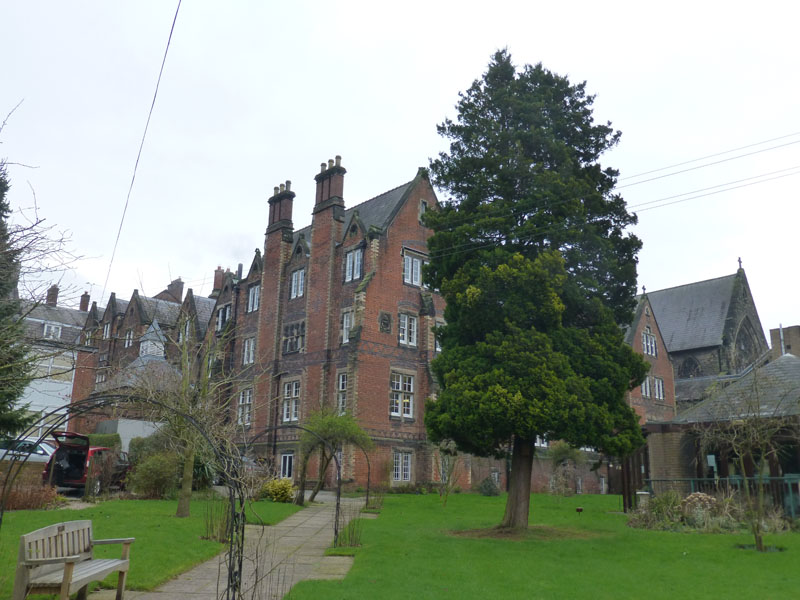
Convent and Church at Stone (largely as in the days of Mary Helen)
A new convent of Dominican sisters was established in Crieff, under the name of St Mary’s and under the patronage of ‘Our Lady, Help of Christians’. The erection of the house was formalised on 18 November 1889, with a mission to run the Catholic school there, called St Dominic’s. This was already open and receiving pupils from 2nd September 1889. The Convent and original school were located at the top of what is now Mitchell Street (on the side nearest the Knock), near the corner with Strathearn Terrace. The property had previously been called Springbank, when owned by the Porteous family. It had one central large house built in the Georgian style towards the beginning of the 19th Century. Standing until 1985, it was latterly considered an ugly building. There were a number of other buildings on the property.
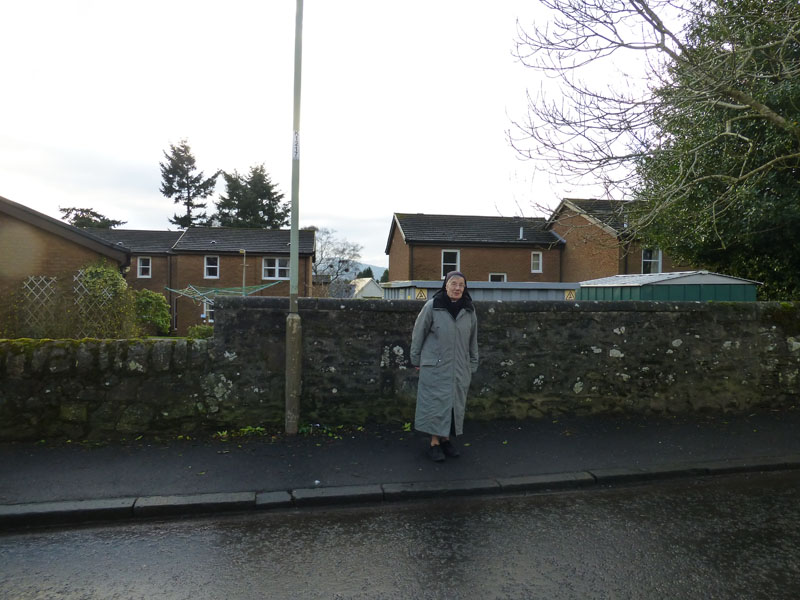
Sr Pauline Burling OP standing beside the wall of St Mary’s Convent
Crieff was not the least promising place in Scotland to open a Catholic convent. After the legal separation from Rome in 1560, Crieff had been Episcopalian until the ‘Glorious Revolution’ of 1689 established Presbyterian Supremacy in the nation. Nonetheless, Episcopalian sympathies and some liturgical expressions lingered in Crieff. The area and its aristocracy were Jacobite in political sympathy, Alexander Murray’s great grandfather being reckoned to have died at Culloden. Before that, in 1687, James Drummond, Earl of Perth became a Catholic and established a chaplain, Fr Cooke, in Drummond Castle from which Fr Cooke reported that “he found the people well inclined, had made a good successful mission and had received severalls”.The Drummonds then provided and housed several Catholic chaplains over the years. Very notably Fr MacDonald served Crieff for 55 years from 1782-1837, and also assisted as far away as Glasgow. He was well respected in the area, even training the Presbyterian school master in Latin. There had been a Catholic chapel on Ford Road from 1799. Inflated by Irish migration owing to the Potato Famine, the Catholic population had grown to about 600 and a new bigger church building was needed. This was erected near to the old one, again accessed from Ford Road, in 1871 under the leadership of Fr Peter Cumming. By this time a Catholic priest was permanently resident in Crieff. The hierarchy and diocesan structure was re-established in 1878 across Scotland.
However, that part of Strathearn Terrace where the convent was located must have had a particularly potent religious atmosphere in those years. In 1882, a new Church of Scotland building, St Michael’s, was put up opposite what became the convent. There had been a number of kirks in Crieff before that. There was a rising (and for Crieff new) surge in low or free Church sentiment around that time, and a split in the congregation led to a new free Presbyterian church being built opposite St Michael’s in 1884. Rather pointedly, the architect ensured that its combination of tower and spire exceeded its rival by six feet. The tensions and division rumbled on for years. It was directly adjacent to what became the convent in 1889.
Two of the half-sisters (Frances and Alice) of Mother Mary Ignatius, its superior, were lodged and cared for in rooms linked to the convent for some time. It seems that the eldest of the half-sisters, Georgina (b 1869) had moved out of the convent buildings before the census of 1891 (if she ever moved in), the census recording only the other two. Frances became a Dominican sister in Crieff, entering aged 19 in 1890, and then being clothed in 1891. This provides clear evidence that she was a Catholic, (or plausibly had become one by 1868, but this is unlikely). After a promising start and final vows, she (Sr Mary Imelda) later left in 1898, in a situation that was difficult and saddening for both sisters. She later married a Mr Bell.
Links with Stone were maintained as far as possible. Initially Stone sent a second sister, Sister M. Benedicta, to accompany Mother M, Ignatius to Crieff. She had been born Katharina Mathieu on 6 June 1836 at Saarbrucken in Germany. She entered Stone on 6 August 1857, was clothed on 2 December of the same year and professed her vows on 1 August 1859.
Once Mother M Ignatius’ vows had been transferred to the local Bishop (in February 1890), she was allowed to receive as novices two women who had already been living with the sisters as aspirants / postulants. Others followed. Over the next decade some came and stayed, others tried their vocation and left. On occasions, sisters joined the Crieff house from various convents established from Stone. Most famous and infamous among these was Sr M Rose Corbett, originally from the Convent in Stroud (who unfortunately raised some difficulties after a promising start, ones previously noted in other convents she had lived in). She was accompanied by Sr M Francis King (the latter from Scotland). Both came in 1896. Others who joined for various lengths of time were from various places in Scotland, England, and Ireland and one from the West Indies, as well as Mother M Ignatius’ half-sister Frances who was born like her in Canada and who took the religious name Sr M Imelda. Other recorded sisters include Sr M Gertrude (nee Anne) McEnerny from Galway in Ireland, Sr M Agnes (nee Honora) Donovan from Cork in Ireland, Sr M Margaret (nee Mary) Bell from Methven, Perthshire in Scotland, Sr M Lucy (nee Mary Frances) Fagan from England, Sr M Monica (nee Mary) Thornton from Dundee, Scotland, Sr M Dominic (nee Mary) Roche from Dublin, Ireland, Sr M Francis Raphael (nee Evelyn) Thompson from Guyana in South America and then part of the British Empire, Sr M Catherine (nee Anne) Taylor from Dundee in Scotland, and Sr M Magdalene (nee Mary Anne) Harris from Dublin, Ireland. In total, 16 women lived the religious life in St Mary’s Crieff.
There were struggles to get religious life properly established and especially to provide adequate formation. Sometimes some of the sisters were sent to other Dominican convents to get experience there. But amidst these difficulties, and comings and goings, the school thrived. From 1891 they were able to employ a properly trained teacher, certificated to Scottish standards. This meant that they could receive a Government grant to assist them financially. (The school dates its official existence from these events in 1891.) A school log book started in 1891 survives to this day, kept by these teachers. It seems the certificated teacher taught the older pupils, while Sr Gertrude was during the whole 10 years, the ordinary teacher of the infants. Other sisters helped on occasions. Mother M Ignatius made frequent visits and inspections. Another widow, Mrs Mabel Fitzgerald, who with her four children also lodged in Springbank, also helped a good deal in teaching and supervising the school. The school passed its first Government Inspection in 1892 and all subsequent ones. Important events in the life of the convent were celebrated by the school as well. By 1896 it was clear the original premises were too small for the growing number of pupils. A new building was begun next to the parish church of St Fillan’s on Ford Road in 1896 and opened to pupils in 1897. Later a pre-school was opened there too. Links with St Mary’s Convent continued.

St Mary Crieff School Shield and emblem showing the open Bible and flaming torches symbols of St Dominic
Sr M Ignatius died on the last day of 1899, having been ill for some time. She is buried in the cemetery on Ford Road, opposite the school she founded, and the Catholic Church she attended. Her gravestone still stands, engraved with ‘In loving memory of Mary Helen Elwes, Foundress and Superioress of St Mary’s Convent, Crieff. Daughter of Alexander Murray, CMG.’ The base quotes the words of Jesus ‘I am the Resurrection and the Life’. At least four reports in the Tablet record events in the life of the convent and school in between the foundation and death of M Ignatius.
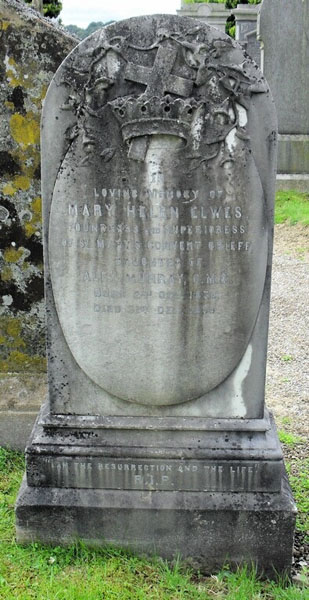
Gravestone of Mary Helen Elwes
As a result of the problems forming enough Dominican sisters to an appropriate level, greatly aggravated by the relative isolation of the convent in Crieff, and by financial problems, Bishop James Smith of Dunkeld, decided to sell off the convent property to cover the debts. Two professed sisters were transferred to other convents. Two postulants resident in the Crieff convent were received into the novitiate at Stone from which Mother M Ignatius had first come. The school, not least since it had wisely employed certificated teachers from 1891, was well placed to continue, further aided by the active support of the parish clergy. Nonetheless it was not until 1919 that it became part of the state system of education, and until then was mainly reliant on Catholic benefactors to fund it.
The school remained on its 1896 site until 1966, when it moved to its present site on Broich Road, a few minutes walk from the church. It continues to bear the name of St Dominic, given at its foundation. Part of the wall of the second building still stands and carries a stone that says ‘1896, St Dominic’s School.’ The original site on Strathearn Terrace, of which part of the external wall remains, is now occupied by sheltered housing. The school continues to thrive, now having about 160 pupils, and is proud of its Dominican connections and values.
It is said that the convent was the first of its kind in Scotland since the Reformation (a claim that needs corroboration), though it is most probably the first foundation in Scotland by Dominican Sisters.

Br Dominic Humbert Edward (Teddy) McLectchie Robertson OP – the school mascot
Written by Fr Andrew Brookes OP, February 2016.
